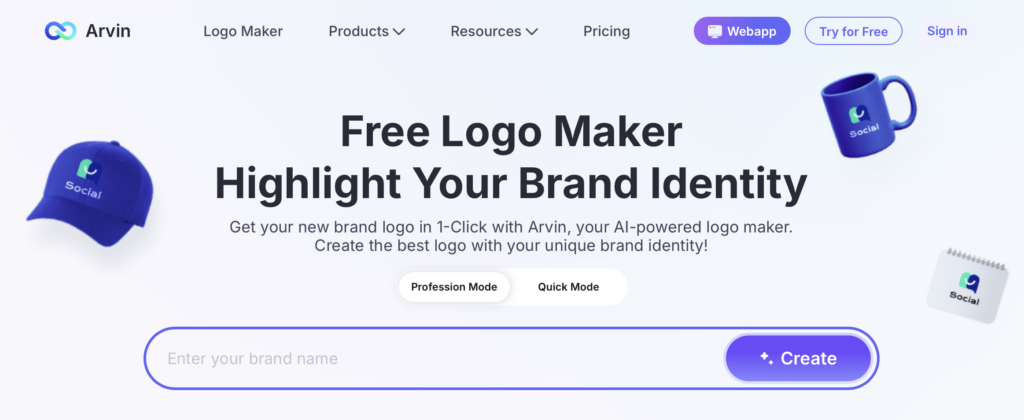
Have you ever been asked, “Where do you see yourself in five years?” or “What defines you as a person?” If so, you’re already one step closer to understanding the difference between a mission vs vision statement. While they might appear similar at first glance, these two concepts serve very distinct purposes. The challenge often arises when you’re tasked with articulating them concisely and effectively.
Mission vs Statement for Business
As you start to fill your business website, you may notice that many successful businesses have a mission and vision statements displayed prominently on their “About Us” page, or somewhere on the website. Apart from potential customers, this clear vision can help their company communicate their core values, and outline a clear mission to their employees and other stakeholders.
What Is a Mission Statement?

A mission statement defines the core purpose of an organization. It articulates why the business exists, who it serves, and how it creates value. It is rooted in the present, describing the organization’s fundamental operations and objectives.
There are several key characteristics of a mission statement, including:
Focus on the present
Customer and value-oriented
Being actionable
a) Focus on The Present
By focusing on the present, the mission statement emphasizes the company’s current role and commitments.

For example, Farmers Union:
At Farmers Union we believe in harnessing the goodness of wholesome ingredients like milk, cream, and cultures to create our delicious range of yogurts that go with just about everything.
b) Customer and Value-Oriented:
A customer and value oriented mission statement explains how the business meets customer needs and delivers value to them.

For example, Zappos‘ mission statement shows that they place their customer at the centre of their mission by prioritising exceptional service.
To provide the best customer service possible. Deliver WOW through service.
c) Actionable
Actionable, in its name, means the mission statement aims to show that it aligns with ongoing activities and strategic priorities.

Patagonia, “We’re in business to save our home planet”, shows the actionable aspect, and emphasizes the brand’s commitment to environmental sustainability driving their business decisions.
It also reflects the company’s long-term focus on combating climate change and protecting natural ecosystems.
What is a Vision Statement?
A vision statement is a forward-looking declaration that articulates what an organization aspires to achieve in the future.

Unlike a mission statement, which focuses on the present and outlines the company’s purpose and actions, a vision statement describes the long-term goals and desired impact of the organization.
Key features of a vision statement include:
Future oriented
Aspirational
Broad yet specific
a) Future-Oriented
Being future-oriented focuses on where the organizations wants to go in the long run, often without specifying the “how”.

IKEA’s vision statement, “To create a better everyday life for the many people”. Their statement shows that they have an aspiration (to) create something better for their customers through affordable and functional design.
b) Aspirational
Google’s vision statement is an example of an aspirational vision statement. “To provide access to the world’s information in one click.”
It speaks of a future where all information is seamlessly accessible to anyone, a feat that, as of yet is still miles away, considering that one third of the world’s population (2.6 billion) does not have internet access. However, this still reflects Google’s ambition to innovate continuously, simplify complex problems and ensure that knowledge is available universally.
c) Broad Yet Specific
Similar to Google, Microsoft’s vision statement “To empower every person and every organization on the planet to achieve more”, is a perfect example of a broad yet specific vision statement.
This vision statement is broad in scope as it encompasses “every person and every organization on the planet”, yet specific in purpose, “to achieve more”. This directly ties into Microsoft’s tools, software, and services that are aimed at productivity, innovation and collaboration.
Mission vs Vision Statement Examples (Table)
|
Company |
Mission Statement |
Vision Statement |
|---|---|---|
|
Microsoft |
“To empower every person and every organization on the planet to achieve more.” |
“To help people and businesses throughout the world realize their full potential.” |
|
Tesla |
“To accelerate the world’s transition to sustainable energy.” |
“To create the most compelling car company of the 21st century by driving the world’s transition to electric vehicles.” |
|
|
“To organize the world’s information and make it universally accessible and useful.” |
“To provide access to the world’s information in one click.” |
|
IKEA |
“To offer a wide range of well-designed, functional home furnishing products at prices so low that as many people as possible will be able to afford them.” |
“To create a better everyday life for the many people.” |
|
Patagonia |
“We’re in business to save our home planet.” |
“A world where people view the environment as a priority and take action to preserve it.” |
Mission Statement Examples
As mentioned above, a mission statement is something that answers “Why does the business exist?”, “Who does the business serve”, and “How does it create value?”. The following examples will show how their mission statement answers these questions.
a) Netflix:
“To entertain the world by delivering outstanding content and an exceptional experience.”
b) Airbnb:
“To create a world where anyone can belong anywhere.”
c) Slack:
“To make people’s working lives simpler, more pleasant, and more productive.”
d) Samsung:
“To inspire the world with innovative technologies, products, and designs that enrich people’s lives and contribute to a socially responsible future.”
e) Intel:
“To create world-changing technology that improves the life of every person on the planet.”
f) Dell:
“To be the most successful computer company in the world at delivering the best customer experience in markets we serve.”
g) HP (Hewlett-Packard):
“To create technology that makes life better for everyone, everywhere.”
h) L’Oréal:
“To offer all women and men worldwide the best of cosmetics innovation in terms of quality, efficacy, and safety.”
i) Adobe:
“To change the world through digital experiences.”
j) PayPal:
“To democratize financial services so that managing and moving money is accessible, secure, and affordable for everyone.”
k) Spotify:
“To unlock the potential of human creativity—by giving a million creative artists the opportunity to live off their art and billions of fans the opportunity to enjoy it.”
l) The Honest Company:
“To empower people to live happy, healthy lives.”
m) Southwest Airlines:
“To connect people to what’s important in their lives through friendly, reliable, and low-cost air travel.”
n) HubSpot:
“To help millions of organizations grow better.”
o) TOMS:
“To improve lives through business.”
p) ASOS:
“To become the world’s number one destination for fashion-loving 20-somethings.”
q) WeWork:
“To create a world where people work to make a life, not just a living.”
r) Etsy:
“To keep commerce human.”
s) Ben & Jerry’s:
“To make the best possible ice cream in the nicest possible way.”
t) Warby Parker:
“To offer designer eyewear at a revolutionary price while leading the way for socially conscious businesses.”
Vision Statement Examples
a) Netflix:
“To become the best global entertainment distribution service.”
b) Airbnb:
“To help create a world where anyone can belong anywhere.”
c) Slack:
“To be a productivity platform that connects teams to their work and the tools they love.”
d) Samsung:
“Inspire the world. Create the future.”
e) Intel:
“If it’s smart and connected, it’s best with Intel.”
f) Dell:
“To drive human progress through innovative technology.”
g) HP (Hewlett-Packard):
“To create technology that makes life better for everyone, everywhere.”
h) L’Oréal:
“To be the leader in beauty innovation and make beauty accessible to all.”
i) Adobe:
“To revolutionize how the world engages with ideas and information.”
j) PayPal:
“To create an interconnected digital economy that allows everyone to thrive.”
k) Spotify:
“To become the world’s largest platform for artists and listeners to connect and grow together.”
l) The Honest Company:
“To reinvent the consumer products industry by building safe, effective, and accessible solutions for families.”
m) Southwest Airlines:
“To be the world’s most loved, most efficient, and most profitable airline.”
n) HubSpot:
“To transform the way businesses attract, engage, and delight customers.”
o) TOMS:
“To create a better tomorrow by improving lives today.”
p) ASOS:
“To be the world’s number-one online destination for fashion.”
q) WeWork:
“To elevate the world’s consciousness through better workspaces.”
r) Etsy:
“To build a human-centered global marketplace that encourages creativity and connection.”
s) Ben & Jerry’s:
“To create linked prosperity for everyone connected to our business.”
t) Warby Parker:
“To be the leading eyewear brand that sets the standard for social and environmental responsibility.”
5 Differences Between Mission vs Vision Statement
|
Aspect |
Vision Statement |
Mission Statement |
|
Focus |
Future-oriented: Describes the organization’s long-term aspirations and goals. |
Present-oriented: Defines the organization’s current purpose and core activities. |
|
Purpose |
Answers “Where do we want to go?” |
Answers “Why do we exist?” |
|
Scope |
Broad and inspirational, emphasizing the ultimate impact or desired future state. |
Specific and actionable, focusing on day-to-day operations and value creation. |
|
Audience |
Primarily designed to inspire employees, stakeholders, and customers. |
Primarily designed to guide internal operations and communicate purpose to customers. |
|
Time Frame |
Long-term, focusing on what the organization hopes to achieve over time. |
Short-term to medium-term, focusing on immediate goals and activities. |
Mission vs Vision Statement Template
Before you start writing your own mission statement or focus on drafting the perfect vision statement, here are some things you need to take not of, in order to ensure relevance.

Identify Your Core Values: What are some of your company’s core values? Do you aim to be a customer centric company? What principles guide your business?
Define Your Objectives: What is the big picture of your company? What is the direction or common goals you want your company to accomplish? Do you want to achieve the lowest possible prices? Establish utmost convenience for your customers etc?
Reduce Business Jargon: It can be quite easy to be carried away by business jargon, especially if you are used to such language. However, take note that the mission and vision statements are meant for everybody, not just employees. So, instead of saying something like,”Create economic opportunity for the tech world’s professionals”, try something like “Our mission is to bring opportunities to people in tech.”
Align with Brand Identity: Ultimately, you want your mission and vision statements to serve different purposes, but still embody your company’s goals and bring inspiration. There is no better way to do that than to ensure that you remain authentic to the brand identity that you want to convey.
Mission Statement Template
A mission statement focuses on the present and defines the organization’s purpose, what it does, and whom it serves.
“To [action] [target audience] by [specific activities or methods] in order to [value or outcome provided].”
Vision Statement Template
A vision statement focuses on the future and defines the organization’s aspirations and long-term impact.
“To [aspirational goal or state] by [inspirational method or contribution].”
Top 20 Companies’ Vision and Mission Statements
Here is a list of the the world’s top companies’ mission vs vision statement.
|
Company |
Mission Statement |
Vision Statement |
|
eBay |
“To enable economic opportunity for individuals, entrepreneurs, businesses, and organizations of all sizes.” |
“To be the world’s favorite destination for discovering great value and unique selection.” |
|
Intel |
“To create world-changing technology that enriches the lives of every person on Earth.” |
“To shape the future of technology and create a better world for everyone.” |
|
L’Oreal |
“To offer all women and men worldwide the best of cosmetics innovation in terms of quality, efficacy, and safety.” |
“To be the leader in beauty innovation and make beauty accessible to all.” |
|
Dropbox |
“To unleash the world’s creative energy by designing a more enlightened way of working.” |
“To simplify life for people by enabling them to work smarter and collaborate seamlessly.” |
|
PepsiCo |
“To create more smiles with every sip and every bite.” |
“To deliver top-tier financial performance over the long term by integrating sustainability into our business strategy.” |
|
Heinz |
“To be the best food company, growing a better world.” |
“To sustainably grow by delighting more consumers globally.” |
|
Ford |
“To drive human progress through freedom of movement.” |
“To become the world’s most trusted company, designing smart vehicles for a sustainable future.” |
|
General Electric |
“To build a world that works by providing technology and solutions that improve quality of life.” |
“To invent the next industrial era, solving the world’s toughest challenges.” |
|
Kellogg’s |
“To nourish families so they can flourish and thrive.” |
“To enrich and delight the world through foods and brands that matter.” |
|
Unilever |
“To make sustainable living commonplace.” |
“To be the global leader in sustainable business, making a positive impact on the world.” |
|
Asos |
“To become the world’s number one destination for fashion-loving 20-somethings.” |
“To inspire a new generation of fashion enthusiasts by redefining online shopping.” |
|
WeWork |
“To create environments that increase productivity, innovation, and collaboration.” |
“To elevate the world’s consciousness through better workspaces and community.” |
|
Etsy |
“To keep commerce human by connecting people with handmade and unique goods.” |
“To create a world where creativity and connection flourish through human-centered commerce.” |
|
Warby Parker |
“To offer designer eyewear at a revolutionary price while leading the way for socially conscious businesses.” |
“To be the most impactful and responsible eyewear company in the world.” |
|
Ben & Jerry’s |
“To make the best possible ice cream in the nicest possible way.” |
“To create linked prosperity for everyone connected to our business.” |
|
Hershey |
“To make more moments of goodness.” |
“To be an innovative snacking powerhouse with iconic brands and sustainable practices.” |
|
Whole Foods Market |
“To nourish people and the planet.” |
“To create a world where healthier choices are accessible to everyone.” |
|
Wells Fargo |
“To help families and businesses achieve financial success.” |
“To be the financial services leader in customer trust and experience.” |
|
The Honest Company |
“To empower people to live happy, healthy lives.” |
“To reinvent consumer products for a better, more sustainable future.” |
Final Words
Being able to distinguish your mission vs vision statement can significantly impact your branding strategy. However, it’s not just about understanding the difference; knowing where to showcase these statements matters just as much.
One key area where your mission and vision should take center stage is your logo. Your logo acts as a visual representation of your brand’s core purpose (mission) and long-term aspirations (vision), tying your identity together in a way that resonates with your audience.

There’s no better way to create a logo that truly reflects your mission and vision than by using Arvin AI’s Logo Designer. It’s quick, intuitive, and tailored to bring your ideas to life.
If you need any help, check out How to Design a Logo From Start to Finish.
FAQ
What is the difference between a mission and a vision statement?
A mission statement defines the purpose of an organization, what it does, who it serves, and how it serves them. It focuses on the present and outlines the business’s core operations. However, a vision statement articulates the long-term aspirations of the organization. It focuses on the future, describing what the company aims to achieve or become.
What is an example of a mission and a vision?
Mission: “To accelerate the world’s transition to sustainable energy.” Vision: “To create the most compelling car company of the 21st century by driving the world’s transition to electric vehicles.”
What comes first, vision or mission?
A vision statement typically comes first because it defines the organization’s future goals and aspirations. The mission statement is developed afterward, as it serves as the roadmap to achieve the vision.
Which is bigger, vision or mission?
The vision is broader and more aspirational, encompassing the ultimate goal of an organization. The mission is more specific and operational, focusing on what the organization does to achieve its vision.


